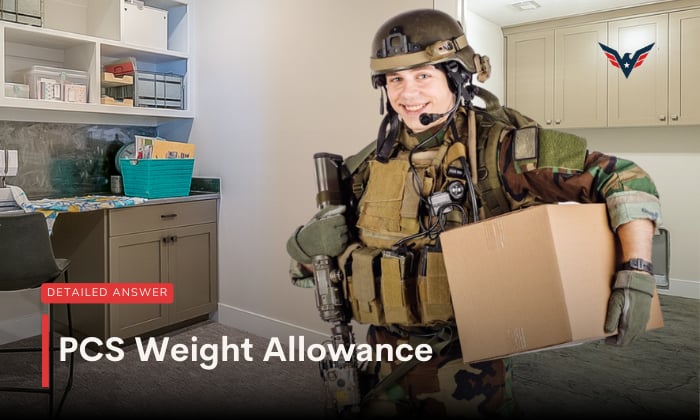During a Permanent Change of Station (PCS) relocation, military personnel and their families are allotted certain weight requirements to transport their things. This is called their PCS weight allowance, and it varies per rank.
It’s important to know the weight limit because going over it could mean extra expenses or having to leave behind necessities. Our guide will help you efficiently and effectively manage this crucial part of your relocation by providing helpful information and tips.
Table of Contents
What is PCS Weight Allowance?
Relocating from one duty station to another is known as a “Permanent Change of Station” or “PCS” in the military. Military personnel are entitled to several privileges and allowances, including a weight allowance for their household belongings when they receive a PCS order.
The term “weight allowance” refers to the maximum amount of household items and personal effects that a service member is permitted to transport at government expense. Military weight limits for PCS are calculated depending on various conditions, such as:
1. Rank
Those in higher ranks in the military may be given more leeway with their weight than those in lower ranks. Whether in the air force, army, navy, Marine, or any other branch, he or she is typically granted greater weight allowances as his/her rank gets higher.
2. Dependents
If a service member has a family to support, such as a spouse and/or children, the government may increase their average weight limit so that they can bring more of their belongings with them.
3. Special circumstances
The weight limit may be changed in exceptional cases. For instance:
- Exceptional Family Member Program (EFMP): The military member’s weight limit may be increased if they have a dependent enrolled in the EFMP who has specific medical or educational needs.
- Command-Sponsored Dependents: Depending on the circumstances, a service member stationed abroad who has command-sponsored dependents may be eligible for a higher weight allowance.
4. Geographic location
The location of the service member’s present duty station and their final destination can also affect the weight limit.
For movements to or from areas outside of the continental United States (OCONUS), the weight restriction may be reduced to account for the higher expense of transporting a larger load.
It is the responsibility of the service member to ensure that the weight of their household goods does not exceed the allotted weight capacity for PCS.
If a service member’s shipment exceeds the allotted weight, they may be required to pay a fine or make other arrangements, such as keeping or selling their excess possessions.
Weight Allowance for Different Ranks and Dependents (as of 2022)
The purpose of the weight allowance table is to provide uniform and reasonable rules for deciding how much weight a household can have during a PCS relocation before the government has to pay more.
In the following table, you’ll find the HHG weight allowance by rank.There are different weight limits for different ranks in the military.
However, these military weight limits apply to all branches. The numbers listed in the following table are the same max weight for the Army, and also the prescribed weight limit for the Navy.
Likewise, the Air Force weight limit also follows this military move weight allowance chart issued by the Department of Defense.
| Rank/Grade | Without Dependents | With Dependents |
|
Enlisted Members |
||
| Aviation cadets | allowed up to 7,000 pounds (or 3,175 kilograms) of household goods )HHG | allowed up to 8,000 pounds (or 3,628 kilograms) of household goods )HHG |
| E-1 to E-4 | allowed up to 5,000 pounds (or 2,268 kilograms) of household goods HHG | allowed up to 8,000 pounds (or 3,629 kilograms) of HHG |
| E-5 to E-6 | allowed up to 7,000 pounds (or 3,175 kilograms) of HHG. | allowed up to 12,000 pounds (or 5,443 kilograms) of HHG |
| E-7 to E-9 | allowed up to 14,000 pounds (or 6,350 kilograms) of HHG | allowed up to 14,000 pounds (or 6,350 kilograms) of HHG |
|
Officers |
||
| O-1 to O-3 | allowed up to 8,000 pounds (or 3,629 kilograms) of HHG | allowed up to 12,000 pounds (or 5,443 kilograms) of HHG |
| O-4 to O-5 | allowed up to 17,500 pounds (or 7,938 kilograms) of HHG | allowed up to 18,000 pounds (or 8,165 kilograms) of HHG |
| O-6 and above | allowed up to 18,000 pounds (or 8,165 kilograms) of HHG | allowed up to 18,000 pounds (or 8,165 kilograms) of HHG |
Other Things to Consider
- DITY Move
These numbers also apply to the DITY move weight allowance. There are compelling reasons for military families to choose a DITY (do-it-yourself) relocation, either entirely or in part. The government will also reimburse you for the cost of moving you.
Unaccompanied Baggage Weight Allowance for PCS Moves
Unaccompanied baggage may be shipped to your new location after you have reported to your new station but before you have found a place to live. Unaccompanied baggage has a maximum weight of 2,000 pounds, though this may be reduced for certain destinations outside the United States, excursions without a guide, etc.
- Packing Material
Keep in mind that the weight of the packing material will be added to the total. The majority of moving businesses believe that the cost of packing materials accounts for approximately 10% of the total. This could be the final straw that sends you over the edge, so pay heed.
Resources and Tools for Calculating Your Weight Allowance
- Weight Estimator Tool
When relocating for a permanent change of station (PCS), military personnel and their families have access to a tool called the PCS Weight Estimator Tool.
Its purpose is to help them comply with the weight restrictions imposed by the military branch and to calculate moving allowance.
- Calculate HHG Weight
Estimating household goods’ weight for an upcoming move is quite easy, and there are two ways to do it.
The first method is to multiply each room of furniture by 1,500 pounds. Don’t forget to include items located in the garage, basement, etc. Another way is to use this household goods weight calculator tool (it’s the third calculator under labeled “Allowances”).
- Pet Transport Guidelines
The purpose of the Pet Transport Guidelines is to ensure the safe and humane transportation of pets apart from meeting the weight allowance for PCS move.
These are guidelines and recommendations developed by the military or particular transportation authorities.
Adherence to these rules helps in ensuring the safety of the pets and satisfies any legal or regulatory requirements during the PCS.
Tips for Managing Weight Allowance Effectively
It’s important to remember that despite the numbers appearing high, possessions can easily accumulate and become quite heavy. Following these simple tips, one can comply with the PCS weight scale and keep within the allowable limit.
- Take photos of everything in your house.
Get an easy start on packing day by updating the housing inventory in advance with photos of every item.
- Don’t bring any damaged items.
Things that are damaged or need repairs fall under this category. Small appliances or electronic gadgets that ate broken, stained linens, and worn-out towels are just a few examples.
- Get rid of or donate unused belongings.
Professional organizers recommend removing anything that hasn’t been used in the last year or two. Donate or discard the contents of any boxes received on the last PCS that were not opened.
- Keep trash and household items in separate containers.
Make sure there is no ambiguity about what belongs in the moving box and what belongs in the trash or charity bin. The movers will be efficiency-oriented and may not make a distinction.
Conclusion
When preparing for a PCS relocation, military personnel and their families need to understand the weight allowance during the army transportation process.
Get a precise calculation of the PCS weight allowance for home goods by considering rank, dependents, and housing status and by consulting the weight allowance chart issued by the Department of Defense.
Relocations and deciding what goes in and out of the moving truck can be overwhelming. However, with the right tools and a better understanding of the process, managing the weight allowance becomes less stressful and more efficient.
Read more: How often does a military family move?

I am Everett Bledsoe, taking on the responsibility of content producer for The Soldiers Project. My purpose in this project is to give honest reviews on the gear utilized and tested over time. Of course, you cannot go wrong when checking out our package of information and guide, too, as they come from reliable sources and years of experience.








